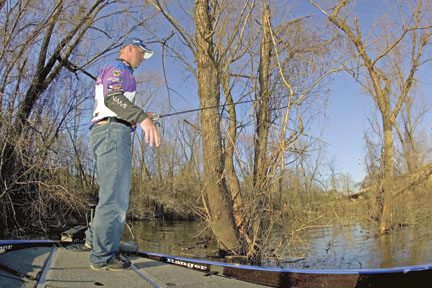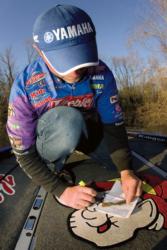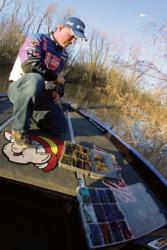Flooded with bass
After the heavy rains fall, employ these different tactics and improve your chances to load the boat

Catching a lunker largemouth is a rite of passage among bass anglers, and spring marks the best time to catch the bass of a lifetime. Spring can also be the very bane of bass anglers’ existence if heavy rains raise the water level of their favorite lakes or reservoirs.
When spring rains inundate your favorite lake, it can mean trees, stumps, picnic tables and shrubs are now underwater until the high water recedes. Some anglers curse rising water, but largemouths react accordingly, and having the know-how to hoodwink them can load the boat in short order. From flipping and pitching jigs to chunking crankbaits and spinnerbaits, there are approaches to help improve your chance for success when the water is high.
“High water in the spring is one of my favorite situations,” said Kellogg’s pro Dave Lefebre of Erie, Pa.
Immediately after heavy rains fall, Lefebre believes it’s time to explore.
“Bass are unsure of exactly what’s going on because of the fresh water and the rapid color change,” Lefebre said. “This period is normally the muddiest.
“I look for back-water ponds, beaver dams, cuts and bays that back up against the main-river flow, like when I won the Mississippi River EverStart Series tournament in 2002. I also look around for weeds or grass. The grass acts like a mud filter and usually causes a slightly clearer area somewhere in, or around it.”
In this narrow window of the “fresh flood,” Lefebre said it’s hard to beat swimming a jig or lizard in the newly flooded grass or bushes.
“I like to throw the bait right up on the bank and pull it into the water,” he said. “A lot of times they’ll smash the bait as soon as it touches the water, or you’ll see a wake coming from several feet away.”
 When it comes to swimming jigs around heavy cover, Lefebre makes long casts and pumps the rod as he reels the bait just under the surface, using a homemade model between 1/8 and 3/8 ounce, with as little of a weedguard as possible. He stays basic with colors: black, white, brown and green skirts, with contrasting trailers.
When it comes to swimming jigs around heavy cover, Lefebre makes long casts and pumps the rod as he reels the bait just under the surface, using a homemade model between 1/8 and 3/8 ounce, with as little of a weedguard as possible. He stays basic with colors: black, white, brown and green skirts, with contrasting trailers.
When lakes are high and stable, Lefebre contends this is the best scenario and the most common in springtime.
“During this time, I’m normally focused on flipping and pitching jigs, tubes and creature baits,” Lefebre said. “I still have the swimming baits rigged for the in-between targets, but I’m focused more on getting something into the cover.”
Lefebre’s two main flipping baits are a Stanley jig, ranging from 7/16 to 3/4 ounce and a Mizmo tube with a rattle. He favors natural colors that match the water, because most fishermen aren’t thinking this way. He highlights the tips of tubes and jig trailers with chartreuse, red or orange, using a dye marker.
Lefebre thinks receding floodwater is the toughest condition for most anglers. When the water starts to fall, the bass feel threatened and begin heading away from the bank, he said.
“One inch is all it takes for the fish to react,” he said. “The biggest problem is that sometimes we don’t realize it’s starting to happen, and we want to do what we were doing yesterday. It’s very important to have marks everywhere so you can tell exactly what the water level is doing everywhere you plan to fish.”
Although the falling-water bite can be tough, bass are very predictable once the fallout is detected.
“They move to the outside edges of the weeds, bushes or trees and even into open water in the middle of bays or pockets,” Lefebre said. “When you find this, you usually find a load of fish in a hurry.
“That was the case at Old Hickory in March last year when I won the FLW Tour event. The high water was steadily falling during the final two days of the event, and the bank fish all pulled out into the middle of a bay with some scattered milfoil. I caught several key fish by fan-casting crankbaits and ripping them off the grass. The water was still high and the flipping cover looked great, but it was coming down a couple of inches a day, and it really affected the fish.”
Like Lefebre, fellow FLW Tour pro John Crews of Salem, Va., has scored big during high-water conditions. According to Crews, the higher the water, the more likely he is to fish near a dam.
 “The lower end of a lake is less affected by high water, such that it won’t be red mud,” he said. “Fish that are used to clear water and then have a slight stain from the high water can bite like crazy. The upper reaches of the lake are more volatile because the water can fluctuate fast and the clarity can change drastically from day to day.”
“The lower end of a lake is less affected by high water, such that it won’t be red mud,” he said. “Fish that are used to clear water and then have a slight stain from the high water can bite like crazy. The upper reaches of the lake are more volatile because the water can fluctuate fast and the clarity can change drastically from day to day.”
Seasoned bass addicts know that when bass are in prespawn mode and the water comes up, a spinnerbait is tough to beat.
If the water is high and you strike out in the flooded cover, recommends this last-ditch effort.
“Fish the lake like it isn’t flooded. Cast crankbaits or a Carolina rig to points where fish would’ve been prior to the high water,” he said. “Sometimes they don’t leave their homes and won’t move up to the new flooded cover.”
If you find yourself befuddled by rising water during the spring on your favorite lake, try these pros’ tactics for surefire success, regardless of where you live. Astute anglers don’t throw in the towel; they change tactics to score on springtime largemouths. Bring on the rain!
High-water tactics
High water resulting from heavy spring rains creates frustration for many bass anglers who don’t know how to catch largemouth bass under these “adverse” conditions; but for savvy anglers, it is during these conditions that you can sack up a big bag of fat, springtime largemouths.
“Anytime you have water that floods a hardwood tree – oak, sweet gum, hickory, etc. – the water will wick up the base, making it appear that the water is falling; but in actuality, the water could be steady,” says pro John Crews. “You have to pay attention to what the water level is doing during springtime high-water situations.”
A better way to tell, he said, is to look at small branches and leaves, because you can see the fresh residue on the leaves and branches, which clearly shows what the water level is doing.
Kellogg’s pro Dave Lefebre of Erie, Pa., cut his teeth fishing in the North on natural lakes, but has made the transition to Southern and Midwestern impoundments. He said the difference in fish behavior between a flooded natural lake and a big, Southern impoundment is minimal.
“It’s simple: In the spring when the water is high, some bass are coming shallow,” he said. “The only meaningful difference is the current on the bigger Southern reservoirs and the way fish position to objects, but everything else is similar.”
Lefebre favors logjams to find high-water bass. He’ll rest his Ranger against the outside logs and pitch a jig or tube into the openings. He’s caught fish 50 feet or more back into a logjam.
“That’s one thing about flooded lakes: You have to have that `no fear’ attitude and not be afraid to put the bait into some gnarly places,” Lefebre said. “If you don’t get the bite, you won’t catch the fish anyway; I’d rather get bit and take my chances getting the fish into the boat.”